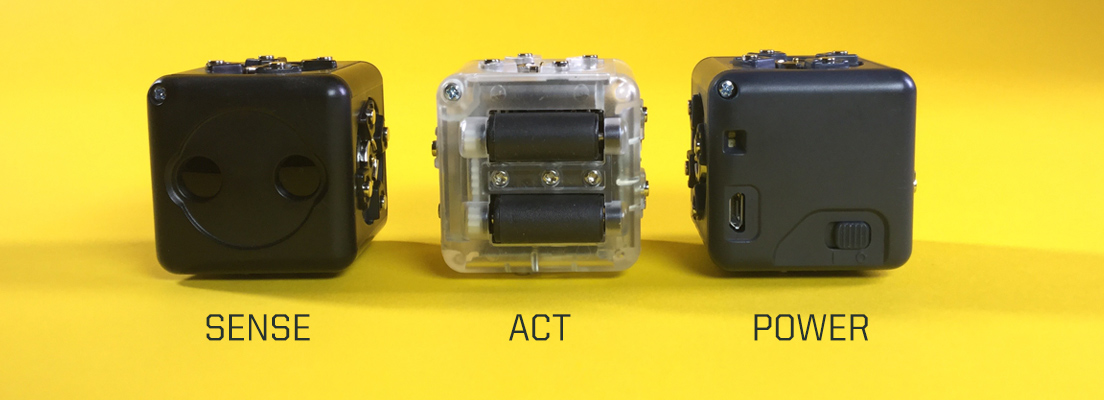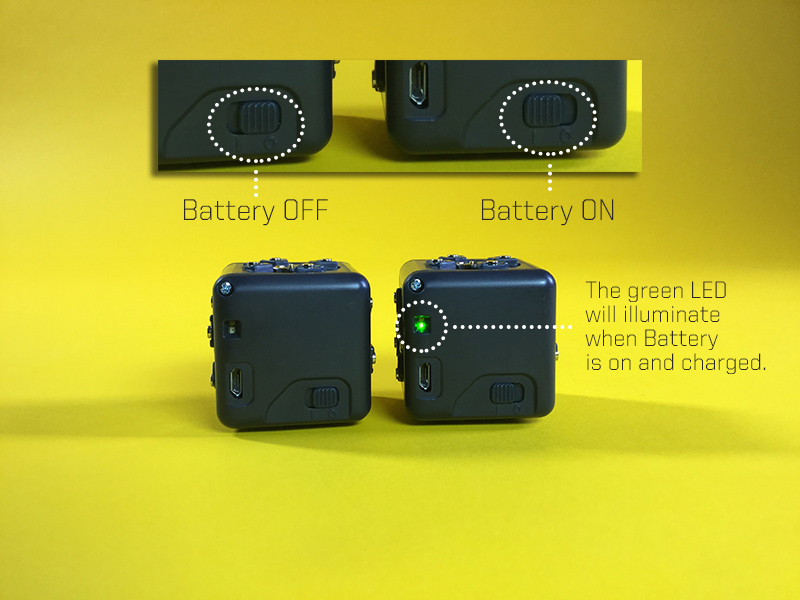A.B.2 | An Introduction and Exploration of Cubelets

Created by: Modular Robotics
Lesson Overview:
This is a hands-on lesson introducing students to the exciting world of Cubelets. It is an exploratory lesson allowing students to discover on their own, with the teacher facilitating, how to use Cubelets to build robots that sense and act. They will intuitively use the scientific method while exploring Cubelets.
Be sure to read the Educator Information Sheet for essential information in understanding how to interpret all the Cubelet lesson plans. We strongly suggest you keep this document handy. As you–and your students–learn more and more about Cubelets, you will find it to be a handy reference tool.
The Basics:
Ages: 7 – 9 years (grades 1-3)Time: 30 minutes
Prep Time: 5 minutes
Lesson Goal (for the educator): To familiarize students with Cubelets and build a three Cubelet robot using the Battery, a Distance Sense, and a Drive Act Cubelet.
Lesson Objective (for the students): I will explore with Cubelets to understand how Cubelets work together to create robots.
Essential Questions: What is making your robot behave? What is it that your robot is sensing? What makes a robot work?
21st Century Skills: Creativity and Innovation, Critical Thinking and Problem Solving, Communication and Collaboration
Concepts: Scientific process/inquiry, theory, testing, data collection
Vocabulary: Stimuli/input, reaction/output, behavior, magnitude
Required Cubelets: Three Cubelets: Distance, Drive and Battery Cubelets – enough for each group of 2-5 students.
Additional Materials: Students’ Robotics Journal
The Standards:
ISTE: International Society for Technology Education- Creativity and Innovation 1.b, 1.a, 1.c, 1.d
- Communication and Collaboration Critical Thinking, Problem Solving, and Decision Making 4.a, 4.b, 4.c, 4.d
- Technology Operations and Concepts 6.a, 6.b, 6.c, 6.d
- ELA-Literacy.SL.1.1, 1.1.A, 1.1.B, 1.1.C, 1.4, 1.5
- ELA-Literacy.SL.2.1, 2.1.A, 2.1.B, 2.1.C, 2.4, 2.5
- ELA-Literacy.SL.3.1, 3.1.A, 3.1.B, 3.1.C, 3.1.D, 3.4, 3.5, W.3.10
Prior Knowledge Necessary for the Student:
- Working as a team during group work
- Understanding of the 5 senses
- Understanding of sense and act
- Understanding of sensing magnitude
Prior Knowledge for the Educator:
- Watch the video Seven Robots.
- Watch the video Getting Started Guide.
- Become familiar with the Cubelets and make some of your own robots to gain an understanding of how they operate.
- In order for students to form theories about the sense component of their robot, they must investigate presenting varying input/stimuli to the Sense Cubelet. In this lesson, students will practice observing behavior and build understanding of stimuli/input and the correlation to reaction/output.
- A robot is a machine that can sense, think, and act on its own. Robotics is the science of designing, building, controlling, and operating robots.
- Steps of the scientific method:
- Ask a question
- Do background research
- Construct a hypothesis
- Test your hypothesis by doing an experiment
- Analyze your data and draw a conclusion
- Communicate your results.
Educator Tips:
- Be sure all students work together and get to experiment with the Cubelets.
- Be sure that all the Battery Cubelets are charged.
- Begin to help students realize they are intuitively following the scientific method as they are working to build their robots.
- As you ask the students questions, encourage them to formulate hypotheses.
- Encourage students, when speaking and recording in their journals, to use the lesson’s vocabulary words when explaining their results.
Preparation:
- Divide the class into groups of 2-5 students.
- For each group, place in a container one Battery, one Distance, and one Drive Cubelet.
- Each student should be given a Robotics Journal with their name on the cover. Let the students know they will be using this journal to record in throughout their study of robotics.
Lesson:
Introduction:
-
Time: 5 Minutes
- “Today you will get to explore with our new Cubelets. Your objective will be to (point to written objective) use the Cubelets to understand how the cubes work together as you make robots. You will be building a simple robot that can sense and act – just like you did when we played the Robot Sensing Game. You will need to work cooperatively with your group and make sure that each person is involved in the work.”
- “Let’s think about our game of Robot Sensing and review the terms sense and act.” Take a minute to call upon students to review these terms with the class.
- Review the Objective and introduce/review the vocabulary. Review the Vocabulary Words that you want the students to know prior to their exploration of the Cubelets. Save the others to review later in the lesson.
- “Today we will make a robot with as few Cubelets as possible. Your team will have three Cubelets: One that senses – that one is black. You also have one that acts – that one is clear. Every robot needs a power source and yours will be supplied by the Battery Cubelet – it is grey and has a switch to turn the power on and off.” Show the class each of these Cubelets and demonstrate how the on/off switch operates and how the green light comes on when the Battery is operating.
- “Whenever a Cubelet is connected to the Battery it will receive power. To be sure each Cubelet is powered, you will look to see that there is a blinking green light on each Cubelet when they are connected to the Battery.”
- “See what your team can discover by using just these three Cubelets. Remembering that you must have a Battery Cubelet, a black Sense Cubelet, and a clear Act Cubelet, investigate how many different ways you can make your robot behave by changing the way you put the Cubelets together. If your robot doesn’t work right away, try putting the Cubelets in a different order. Investigate how many different ways you can make your robot behave by rearranging the Cubelets into different configurations. See if you can figure out what the robot is sensing.


Time to Explore:
-
Time: 5-8 Minutes
- Allow the students to explore and work together making their team robots.
- Optional: Have your students use worksheet A.1.WS – Robots and How They Behave to help them keep track of the robots they build.
- To facilitate this, walk around the room asking questions such as the following:
- What do you think is causing your robot to move?
- What could your robot be sensing?
- How can you test for this? Encourage them to try something like clapping, speaking to it, etc.
- Help them notice that whenever they come close to the black Sense Cubelet the robot moves.
- What makes your robot stop moving?
- Your robot is moving forward, can you get it to move backward?
- Can you get your robot to move in a circle?
- How many different configurations can you make, and how does each effect the action of your robot?
- Can you build your robot to be taller than one Cubelet high?
- Are there other ways to get your robot to move besides using your hand?
- If you could use this robot for a task, what might you get this robot to do?
- If you could add another Act Cubelet to this robot what might that Act Cubelet be, and what might your robot be able to do?
- Stop the class and ask some of the groups to share what they have discovered.
- Ask them “What could your robot be sensing?” and tell them to test this out. Remind them that robots might be sensing different things than humans sense. You want them to notice that whenever they get close to the robot it moves.
- Students will often use their hands over the sensor and this can lead them to conclude that the black Cubelet is sensing heat or people. Point out to them that they should test this theory by seeing what happens when they use other objects. Also, have them consider what causes the robot to move faster or slower – these pointers will help direct their investigations toward considering distance.
- Then, allow the students to explore some more with their new knowledge
- Stop the class again and give them time to record their observations and conclusions in their Robotics Journal. Encourage them to use words and other methods of recording such as charts, sketches, flow charts, etc.
Time: 5 Minutes
Time: 5 Minutes
Closure/Evaluation:
-
Time: 2-3 Minutes
- Recap with students what they learned in this lesson. Try to get them to articulate that a robot needs to sense and act in order to work, and, by controlling or changing the stimuli, one can change the behavior. Also, get them to realize that the direction of the wheels on the Drive Cubelet effects the direction the robot will move.
- Allow time for students to put materials away and plug in the Battery Cubelets for recharging.
Time: 2-3 Minutes
End Results:
Students should be able to build robots that sense and act. They should understand that the input/stimuli received effects the reaction/output of the robot.
Optional Quick Write for Prompt and/or Evaluation:
What did you learn about Cubelet robots today? Use your words and images/sketches to explain.
What to go to Next:
For More Review:Note: At times, you will notice that the lessons may be the same for the students at different levels, this is because many lessons are essential to all students – especially in the beginning as they learn the basic concepts involved in using Cubelets.
This work is licensed under a Creative Commons Attribution-ShareAlike 4.0 International License.


